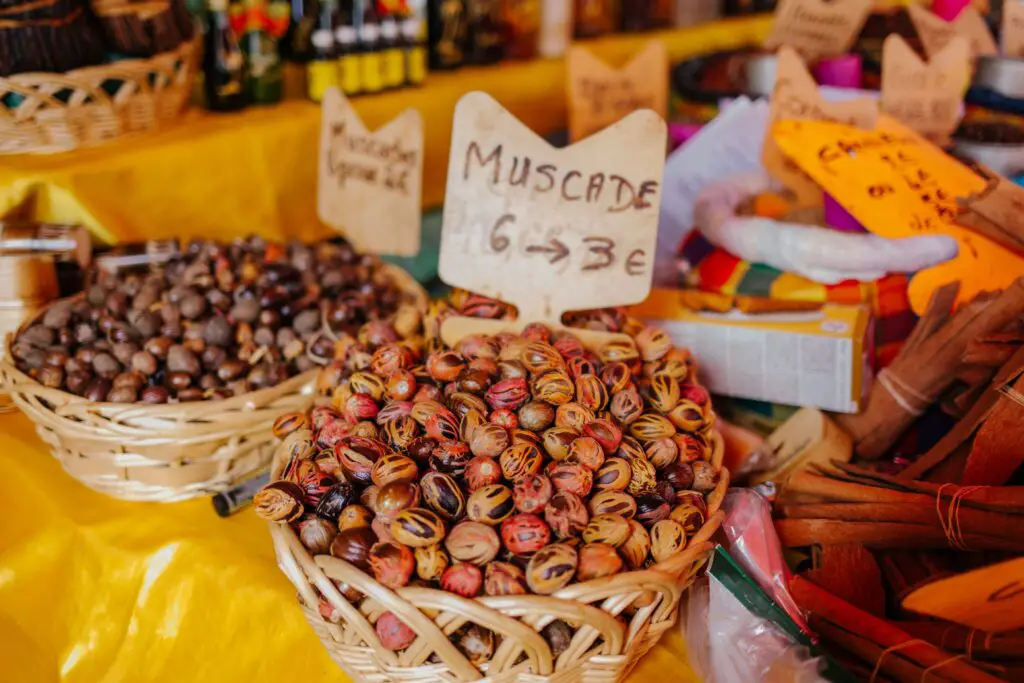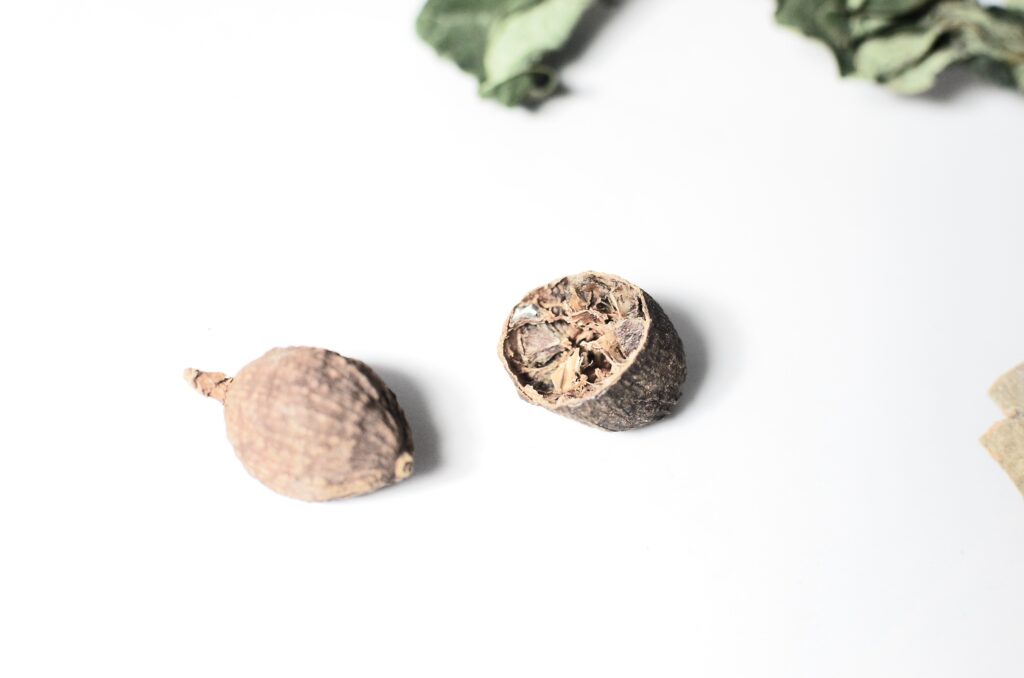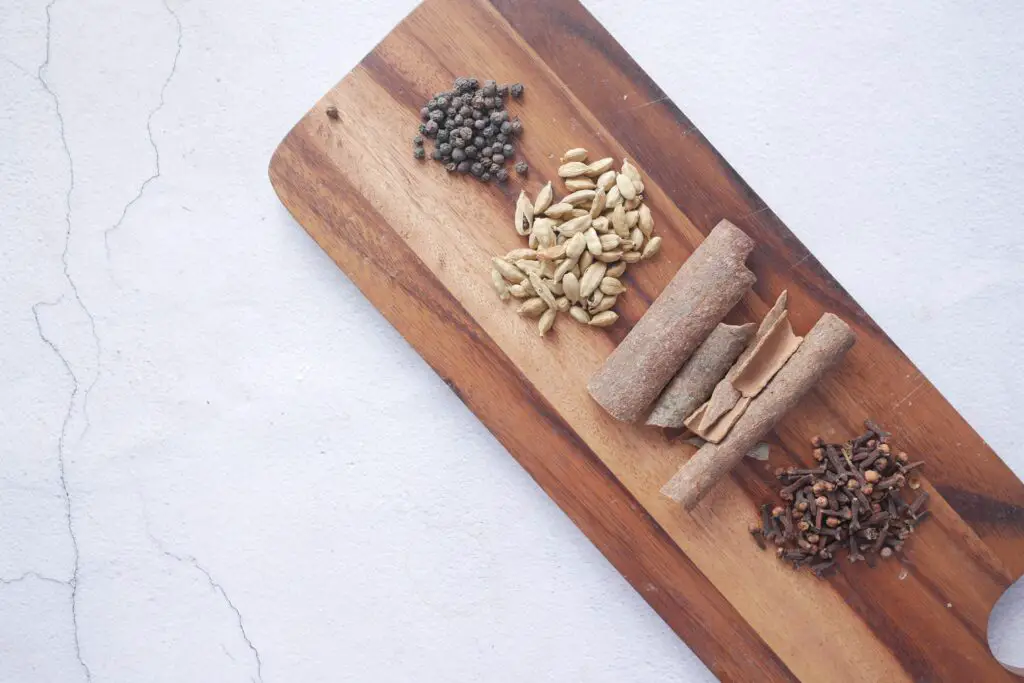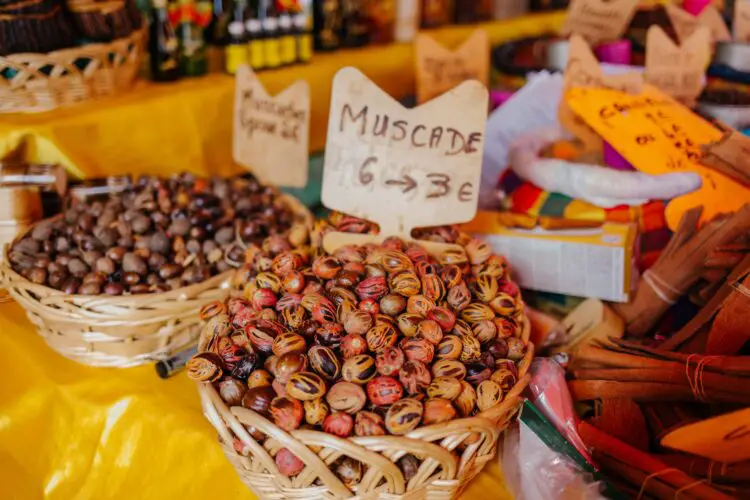Wars have been fought over it, entire continents have been exchanged for it, why is nutmeg so valuable?
Nutmeg has a deep, sweet, and woody flavor that is suitable for both sweet and savory dishes. The spice is used sparingly as it is rich in tannins which give it a penetrating and astringent taste that can overpower delicate spices. Nutmeg is also a known tonic, exciting the heart, which gives it its perceived aphrodisiac properties.

Where does nutmeg come from?
Nutmeg is native to the Banda Islands which form the Moluccas archipelago of Indonesia and made its way to the Byzantine empire by the 6th century. This spice was so prized for its flavor and aphrodisiac and healing properties that traders kept its origin secret to ensure its rarity. Europe in the 16th century valued this spice so much that it was worth more than its weight in gold, which triggered a race to find and control its source. Portuguese explorers were the first Europeans to find and claim the Moluccas in 1511, only to lose to the Dutch in 1599 who then lost 2 of the islands to England in 1603. This partial loss of the production center of nutmeg prompted the Dutch to cede New Amsterdam to the English in exchange for one of these islands. A fair trade? New Amsterdam is now known as New York City…
Nowadays, nutmeg is grown throughout the Maluku islands and has been propagated to Sri Lanka, the Caribbean (where Grenada is the leader), and South Africa.
Is nutmeg a nut, a tree or a plant?
Nutmeg is the seed of a tropical evergreen tree. The fruits of this tree are cut open and dried. The lacy aril is removed to make mace while the seed shell is cracked open to reveal the nutmeg seed. The fruits can be harvested several times a year, with a single tree producing more than 10,000 nutmegs in a single year.
The trees themselves are astonishing, growing up to 40ft (16m) in height, and bearing bell-shaped flowers that smell like lily-of-the-valley.
The dried nutmeg seeds are brown-grey ovals with a ridged surface – ideal for a grater.
Nutmeg as fruit is used in Indonesia, prepared with sugar syrup or coating to make jam, candy, juice, chutney, and pickles.

What does nutmeg smell like?
Nutmeg’s botanical name, Myristica fragrans says it all… “fragrance of myristicin”, which has a warm, woody, balsamic smell with eucalyptus tones and an orangey/peppery note. At least that is what you get when you grate a nutmeg seed and smell the fresh gratings. It is important to grate the nutmeg prior to smelling it as nutmeg tends to lose its outer layer of oil quite quickly, preventing the fragrance of nutmeg from being detected.
Most people are familiar with ground nutmeg, which will have lost most of its essential oils and therefore will tend to smell flat and woody.
Recently, neolignans have been found in nutmeg. While these strictly do not have a smell, they do create a lingering, numbing sense of coolness in the mouth, which adds to the experience.
Flavor Chemicals in Nutmeg, what does nutmeg taste like?
Slightly sweeter than mace, nutmeg is ubiquitous to bechamel sauce, custards, eggnog, curries, onion- or milk-based sauces, and baked or stewed fruits.
Nutmeg has a unique blend of essential oils which combine to create an unforgettable taste. Most chefs tend to overuse this spice, which really needs to be treated with respect. The easiest mantra to remember here is – less is more!
- Myristicin – woody / warm / balsamic
- Eugenol / Cineole – eucalyptus / penetrating / clove-like / fresh minty
- Geraniol / Safrole – rosy / sweet
- Sabinene – orangey / fruity / peppery / woody
- Pinene – conifer like (pine needles)
- Neolignans – tigger the temperature-sensing nerves on the tongue and in the mouth, creating a lingering, numbing sense of coolness.

How to use nutmeg:
Nutmeg is a very powerful spice that can very easily overpower a dish, though the flavor oils of nutmeg are very short-lived and dissipate very rapidly with heat, As the oils evaporate quickly, nutmeg is best used at the end of the cooking time, or served as a condiment on the table. A portion is usually one stroke on a grater if the nutmeg is fresh.
Food partners:
- Lamb: add a generous grating to a meatball mixture or moussaka
- Sauces: add to a bechamel, cheese fondue, souffle or Caribbean nutmeg ice cream to lift the dish
- Drinks: add a light sprinkling to Indian golden latte (haldi doodh) or eggnog to add a little kick
- Spinach: grate into a spinach and ricotta ravioli or creamed spinach
- Cauliflower: sprinkle a scant amount over steamed or boiled cauliflower
- Sweet bakes: sprinkle over custard tarts or in a Sienese panforte to add a light minty freshness and piquancy
Perfect blends:
Most people are familiar with the traditional holiday blends – nutmeg, cinnamon, star anise, and clove, all warming flavor that are synonymous with holiday comfort. However, there are further blends with are an ideal pairing for nutmeg.
- Turkish baharat
- Bumbu
- Jamaican jerk rub
- Mulling spice
- Quatre epices
How to enhance the flavor of nutmeg:
| Chemical | Flavor being enhanced | Complementary spice | Effect |
|---|---|---|---|
| Myristicin | warm | Ginger | zesty heat with a citrus-sweet crossover |
| Myristicin | warm | Black Pepper | citrusy heat with floral hints |
| Myristicin | sweet / woodiness | Anise | contains myristicin, thus increasing this component |
| Eugenol / Cineole | eucalyptus / penetrating | Cardamom | floral sweetness with hints of camphor |
| Eugenol / Cineole | fresh minty/penetrating | grains of Selim | adds a medicinal camphorous flavor similar to rosemary |
| Eugenol / Cineole | fresh minty/penetrating | clove | adds depth and sweetness |
| Eugenol / Cineole | fresh minty/penetrating | cassia | compliments nutmeg |
| Geraniol / Safrole | rosy | allspice | adds a floral bouquet |
| Geraniol / Safrole | sweet | curry leaf | compliments nutmeg |
| Sabinene | peppery | garlic | adds piquancy and sulfurous piquancy |
| Sabinene | orangey | juniper | adds citrus notes |
How to grate nutmeg?
As fresh nutmeg can be very overpowering the best way to grate nutmeg is with a nutmeg grater. This is a small, fine, or Microplane grater that is perfectly sized to provide a single portion per downward stroke. If you do not have this grater, it is best to use a very fine-toothed grater and apply a gentle stroke, roughly 2in or 5cm long.
Some people will buy a nutmeg grinder. This specialized device mimics a nutmeg grater, with a single rotation equating to a stroke on the grater. This device is not always ideal as the nutmegs are often free to rotate in the grinder, thus not always exposing the freshest surface to the grinder.
Here are some tips on how to grate whole nutmeg:
- Crack the shell of the nutmeg by smashing it – some people like to use a nutcracker.
- Remove the shell completely as it has little flavor.
- Hold the grater over a plate or dish at a 45 degree angle.
- Slide the nutmeg down the grater in one smooth motion.
If your nutmeg has not been used in a while, just glide the old face of the seed on your grater once or twice to remove the old, dry, tired and flavorless surface and expose a fresh layer that is packed with oils.
Substitutes for Nutmeg
Sometimes, nutmeg is simply not an option – perhaps you want to make a white sauce, which would be marred by the presence of nutmeg flecks, or you try to make smooth ice cream and the grittiness of shavings simply throw the dish out. In such cases, an alternative to nutmeg is needed.
Mace, which is made out of the same fruit as nutmeg, is the closest spice that comes to mind. While there is no prices replacement for nutmeg, mace comes pretty close, especially, if extra spices are used.
Here are some great substitutes for nutmeg in your cooking:
- Allspice: Allspice is a berry from the Jamaican Bayberry leaf which is also high in eugenol, giving it a similar woody, warm flavor. As allspice is commonly found in kitchen pantries it is a convenient replacement for nutmeg. As such, allspice is a good partial substitue, using a 1:1 ratio.
- Mace: Mace is made from the outer layer of the nutmeg seed. As mace has a very similar, yet subtler flavor, you can replace nutmeg with 1.5x the amount of mace.
- Cinnamon: gound cinnanmon looks like nutmeg and while sweeter, it has a similar taste to nutmeg when used sparingly as an undertone. Do not use cinnamon in recipes that call for both nutmeg and cinnamon. Replace nutmeg with 1/2 the amount of cinnamon.
- Cloves: in small amounts, cloves bring a warming, earthy and aromatic flavor while also numbing the palate. Just add a dash of cloves instead of nutmeg.
- Ginger: ginger has a fruity flavor with hat and zing, similar to nutmeg when used sparingly as an infusion. Due to the potency of ginger, half the amount of nutmeg is recommended.
- Apple pie spice: this spice mix is normally made from cinnamon, cardamom and allspice, thus already has a similar, yet sweeter taste. Simply repalce the nutmeg of this spice and reduce the amounts of the other spices if used in the recipe as well.
- Pumpkin spice: pumpkin pie spice substitues the cardamom of apple pie spice mix with ginger. Some versions are made from cinnamon, ginger, cloves, allspice and sometimes nutmeg itself. This makes a direct replacement tricky as the recipe may require these spices.
- Garam Masala: Garam masala is a popular Indian ground spice mix with cumin, cinnamon, mace, cloves, bay leaves, coriander, and cardamon. This complex mix already has mace, a nutmeg substitute but can also have nutmeg added to it. As it is a complex blend, start by replacing the nutmeg wiith 1/2 the garam masala.

Mace vs Nutmeg
Nutmeg comes from a tropical evergreen tree that produces two distinct spices: nutmeg – the seed and mace, its lacy covering.
While nutmeg and mace are often used interchangeably, especially in sweet dishes, a refined palate can tell the difference. Where nutmeg is bittersweet, woody, and warm, mace is sweet, warm, and aromatic. While nutmeg has to be grated, which leaves flecks in pale creams and clear broths, whole blades of mace can be used instead – simply remove the blade prior to serving!
Nutmeg is stronger than mace and therefore less is needed. The accepted ratio is 1 teaspoon of mace = 1/2 teaspoon of nutmeg.
Recipes with Nutmeg
- Coffee with nutmeg
- cookies with nutmeg
- tea with nutmeg
- Silky nutmeg ganache
- Chocolate, Orange and spice fondue
Grated nutmeg vs ground nutmeg
While many stores sell ground nutmeg, this spice should always be used fresh as its flavor oils are amongst the quickest to evaporate. Freshly grated nutmeg has a heady aroma that fades away quite rapidly. Freshly grated nutmeg will start to lose flavor after about 30 minutes in the summer. After a day, it is will have lost 90% of its vibrancy, leaving a woody taste behind. Imagine the store-bought grated nutmeg… how long has it been on your shelf? How long since it was manufactured?
Nutmeg storage and shelf-life:
Whole nutmeg keeps for at least a year if stored in a sealed container kept in a cool, dark place. Discard as soon as black spots develop. Ground nutmeg can keep for a year under the same conditions, though the flavor will fade within a month and the remaining product tends to be bitter and flat. If buying ground nutmeg, try to keep the bottle as steady as possible as the outer layers of nutmeg powder can act as an insulation layer, trapping the flavorful oils deeper inside.

